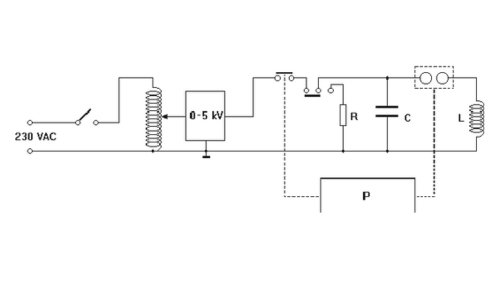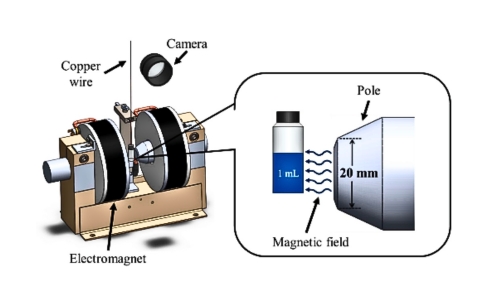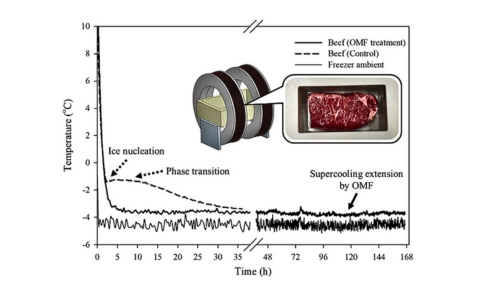INTRODUCTION
- Oscillating Magnetic Fields (OMF) are known for their microbial inactivation methods.
- The OMF is applied as decaying or constant amplitude sinusoidal waves.
- The Magnetic Field’s primary advantage over other methods is its interaction with the food, which considers both thermodynamic and quantum effects.
Oscillating Magnetic Field Working and Equipment
- Electromagnets produce oscillating magnetic fields by passing a fluctuating current. The field strengths are high when compared with the earth’s magnetic Field, which would approximately be 5 to 100 tesla.
- Frequencies ranging between 5-500 kHz are applied for around 25µs to a few milliseconds. This helps in the inactivation of vegetative cells.
- However, if the frequencies exceed 500 kHz, the food gets heated, and the inactivation process is ineffective [1].
 Figure 1: Schematic diagram of an Oscillating Magnetic Field [2]
Figure 1: Schematic diagram of an Oscillating Magnetic Field [2]
Magnetic Field and its Effect on the Properties of Food
- Magnetic Field caused an increase in the average weight and the content of lycopene and total soluble solids in cherry tomatoes. The increase was higher in Pulsed Magnetic Field (PMF) than in Static Magnetic Field (SMF).
- An increase in plant metabolism and ion concentration was noticed when Magnetic Field was applied to strawberries, according to a study by Eşitken and Turan.
- Oscillating Magnetic Field prolonged the shelf-life of cantaloupes to a great extent, per the findings of Jia et al.
- When Magnetic Field was applied, the release of ascorbic acid and sugars was noticed in honey. The underlying mechanism is attributed to pH reduction and an increase in soluble solids that caused the disintegration of macromolecules like pollen.
Effects of Magnetic Fields on Food Enzymes
- Selecting the Magnetic Field activity level depends on whether enzyme stimulation or inactivation is desired.
- Jia et al. substantiated that Magnetic fields can alter the enzyme structure. When subjected to SMF, a change in the four secondary conformations of α-amylase was noticed.
- A study by Mizuki et al. revealed that the activity of α-amylase had increased when OMF was applied at 5Hz frequency
Effects of Magnetic Fields on Microorganisms in Food
- PMF at 5 to 50 T, 1 to 100 pulses, 5 to 500 Hz, 0 to 50 °C and 25 to 100 μs of exposure time significantly decreased microorganism growth by at least 2 log Colony Formation Units (CFU). The suggestions were given by Barbosa-Cánovas et al. for inactivating microorganisms in sealed food.
- Applying OMF caused a decrease in the growth of Escherichia coli in a broth containing yeast extract, according to a study by Strašák et al.
- A study by Bayraktar revealed that OMF limited the growth of, or even caused the death of Saccharomyces cerevisiae due to a change in enzymatic activity. Those that survived exhibited a higher activity.
- While high-intensity PMFs destroy microbial cell membranes and organelles, low-frequency MFs significantly impact cells and tissues [3].
Other uses of Oscillating Magnetic Field
- Oscillating Magnetic Field is gaining considerable interest since it shows supercooling properties, rendering its use for preserving food [4].
Critical Process Factors
- A constant-volume preservation method in a closed rigid container can better retain the food’s quality. For instance, potatoes lose weight at the same temperature in an isobaric freezing system. In contrast, when stored in an isochoric refrigeration system (5 °C) system immersed in a 10% (w/w) sucrose solution, potatoes experience no weight loss.
Magnetic Field Characteristics
- The growth and reproduction of microorganisms may be stimulated or inhibited by exposure to Magnetic Fields.
- Inactivation studies often show inconsistent results, making it impossible to assess the microbial inactivation efficiency of magnetic fields or predict its effects on microbial populations.
Electrical Resistance
- The electrical resistance of food needs to be greater than 10–25 Ohms-cm to allow OMF microbial inactivation.
- Most foods have electrical resistance within this range; for example, orange juice resistance is 30 Ohms-cm.
Temperature
- Berk et al. (1997) evaluated the Effect of 71 and 106 mT static magnetic fields on three potentially pathogenic amoebae. They found that the number of amoebae in the three species was significantly reduced after exposing them to a magnetic field for 72 hours at or above 20oC [1].
Conclusion
- MFs applied in different frameworks lead to promising results in transforming and preserving some foods concerning their physicochemical, enzymatic and microbiological characteristics.







